Distinguishing Patterns by Relationships
Similarity and Slope
MINDS ON
Triangles in a Puzzle
A tangram is a Chinese geometric puzzle. It is a square that is cut into seven pieces - 5 triangles, a square and a parallelogram.
The shapes can be arranged to create various other shapes.

Tangrams are available in many sizes and colours. Regardless of the size or colour, the relation between the shapes remains the same. You will investigate the relation between the 5 triangles in the puzzle. Print and cut out the 7 puzzle pieces (tans) in the tangram U2A8 Tangram.
Triangles can be classified using the measure of the angles (acute, obtuse or right angle) in the triangle as well as using the number of equal sides (equilateral, isosceles, scalene) in the triangle.
What kinds of triangles can you find in the tangram? Describe them using correct vocabulary.
There are 5 right isosceles triangles. Each triangle has a right angle and the two legs of each triangle are the same length. There are 2 large, 1 medium and 2 small triangles.
If the triangles are right isosceles triangles, what is the angle measure for the non-right angles?
Each non-right angle measures 45°.
Open Right Isosceles Triangles to check this out.
This tells me that the 5 triangles are:
a) Equal
b) Equivalent
c) Similar
d) Symmetrical
c. Similar. The term that describes triangles that have the same shape (i,e, the same sized angles) but do not necessarily have the same side lengths is similar.
You also know that the ratio of corresponding sides of two similar triangles is equal. When you write the two ratios as an equation, it is called a proportion(definition:statement that two ratios are equal).
You can use the proportion to determine an unknown side length, if you know the other 3, by substituting the known lengths and solving for the unknown length.
You probably notice that some edges of the triangles follow the grid lines while others cross through the grid lines.
You can count the number of units along the hypotenuse of the smallest triangle (10 units) as well as the number of units along the hypotenuse of the largest triangle (20 units).
Because the triangles are similar, you know that all the side lengths of the largest triangle are two times the side lengths of the smallest triangle. The length of the legs in either triangle are not known since you can not count the number of units.
Why would it be incorrect to count the squares to measure the length of the leg of the smallest triangle?
The leg runs diagonally through the square and we don’t know the length of the diagonal, so we can’t count.
What mathematical relation connects the side lengths in a right triangle?
The Pythagorean Theorem states the relationship between the legs and the hypotenuse in a right triangle.
You have usually used the Pythagorean Theorem for a right triangle that has three different side lengths. In this example, you will see how the Pythagorean Theorem can be used to determine the length of the legs in a right isoceles triangle (a triangle that has two sides of equal length is isosceles).
1. Information: hypotenuse =10 units, a and b are equal so a = b.

2. Write the formula, using the chosen variables. Since a = b, you can use the same variable to represent both. Choose a, for example.
3. Substitute the known values for the variables into the equation. Simplify if possible: Since a2 and a2 are like terms (same variable raised to the same power), they can be added together.
4. Calculate. Square 10. Divide both sides by 2. Take the square root of each side.
After rounding to two decimal places, we can confirm that the length of the leg in the smallest triangle is therefore 7.07 units.
Determining Unknown Length in Largest Triangle
Now that you have the length of the leg in the small triangle, you can use the proportion (definition:statement that two ratios are equal) to determine the length of the leg in the largest triangle.
There are different ways that you can use to solve a proportion. You can use an equation, a ratio table or a graph.
Method #1 - Solving the proportion as an equation:
1. Information: hypotenuse large = 2, hypotenuse small = 10, leg (length of side) in large = ?, leg (length of side) in small = 7.07.
2. Substitute the values into the formula. Notice that there are now values in 3 of the 4 positions.
3. One way to solve for the unknown value, ?, is to simplify the left side of the equation.
4. You can multiply both sides of the equation by 7.07 to simplify the right side.
5. Simplify both sides of the equation.
The length of the leg is 14.14 units, twice the length of the leg of the smallest triangle.
Method # 2 - Using a Ratio Table:
A ratio table is a table where equivalent ratios or rates fill the columns. We can fill the first column with the values for the smallest triangle and the second column with the values for the largest triangle.
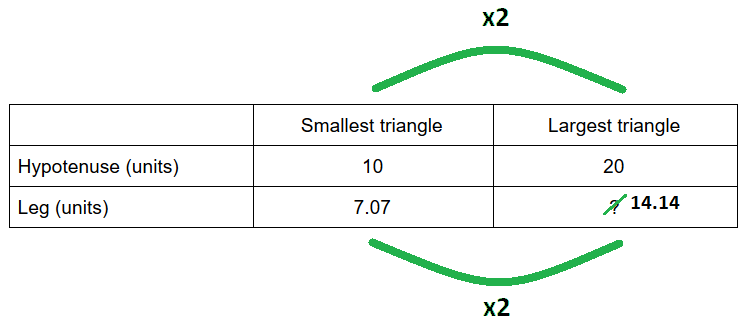
Method # 3 - Using a Linear Relation
You have seen previously that proportional relations pass through the origin. You can create a graph and an equation using the values for the hypotenuse and the leg of the smallest triangle (10, 7.07) and the origin (0, 0).
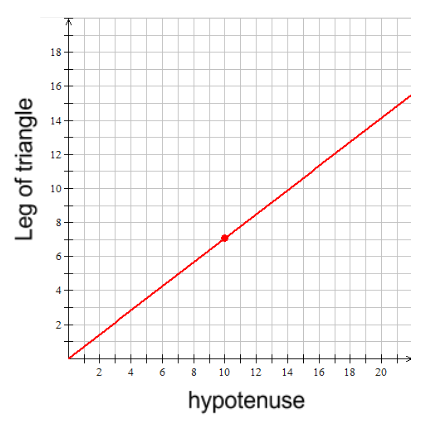
To determine the equation of the line, you can calculate the slope of the line.
From these calculations we find that m = 0.71 when rounded to 2 decimal places.
Since the y-intercept is 0 the equation for the line is y = 0.71x.

You can estimate the point from the graph (when x = 20) or substitute the value x = 20 into the equation to get a more accurate answer.
y = 0.71x
y = 0.71(20)
y = 14.14
You have all the side lengths in the smallest and largest triangles.
Determining the Length of the Hypotenuse in the Middle Triangle
You can use the grid lines to determine the length of a leg in the middle triangle.
Method #1 - Solving the proportion as an equation
1. Information: hypotenuse medium = ?, hypotenuse small = 10, leg in medium = 10, leg in small = 7.07
2. Substitute the values into the formula. Notice that there are now values in 3 of the 4 positions.
3. One way to solve for the unknown value of ? is to simplify the equation.
4. You can multiply both sides of the equation by 10 to simplify the equation.
5. Simplify both sides of the equation.
From these calculations we find that the length of the hypotenuse is 14.14 units.
Method # 2 - Using a Ratio Table
The value to use for multiplication is not as easily seen. We can start by determining the unit rate (an amount for one item) for the leg.
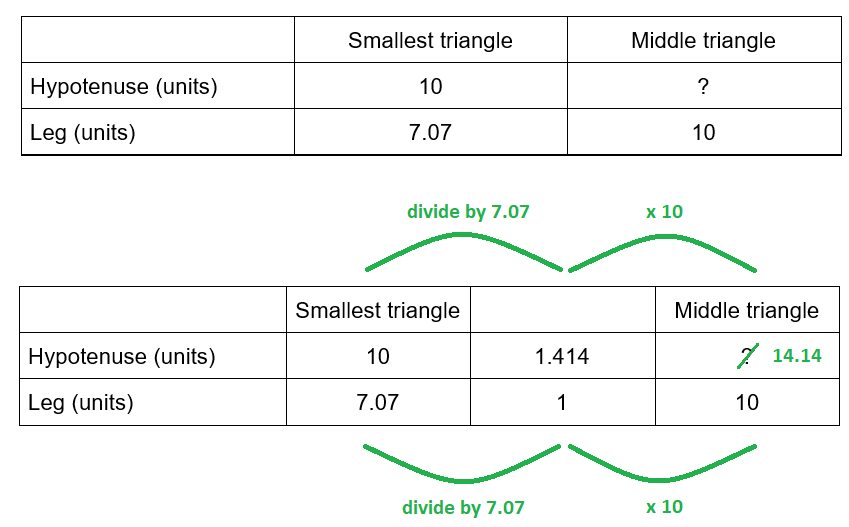
We can tell by the work in the table that the of the hypotenuse on the middle triangle is 14.14 units.
Method # 3 - Using a Linear Relation
Since the middle triangle is similar to the other two triangles, the same graph and equation can be used. With this problem, you have the leg of the triangle which is the dependent value (y) in the representation.
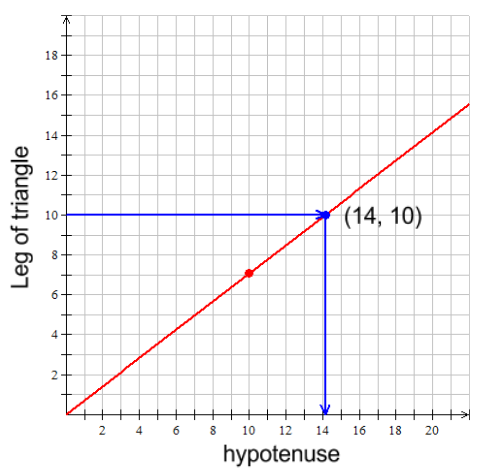
Using the graph, you can approximate the value for x as 14. You can also use the equation.
y = 0.71x
You know the value for y is 10.
Substitute y = 10 into the equation.
10 = 0.71x
14.14 = x
The hypotenuse is 14.14 units.
Method #4 - Using the Pythagorean Theorem
Since you know the 2 leg lengths for the triangle and need to determine the hypotenuse, you can use the Pythagorean Theorem to determine the hypotenuse.
The hypotenuse is 14.14 units.
There are often different methods for finding a solution. It is useful to know how to use different solution methods. One method may sometimes be a simpler method to use than others.
The following video will take you through some further practice solving proportions:
ACTION
 Mathematical Processes
Mathematical Processes
In this activity, the Mathematical Process Connecting is the focus.
Open your document U2 Mathematical Processes and read the descriptions for the process.
As you complete the activity, notice when you are making connections and insert your record below the description of the process.
Slope and Scale Factor
Δ
You know this because each triangle has angles of 95(deg), 32(deg) and 53(deg). You can calculate the ratio of the corresponding sides to determine the scale factor between the two triangles.
The scale factor is a value between 0 and 1 so you know that

You also know that proportional relations are linear relations that pass through the origin. You can create a graph of the corresponding lengths.
If the side lengths of
Watch the short video that shows graphing the ordered pairs and determining the equation of the line that passes through the points.
You can also calculate the slope and determine the equation of the line using the formulas. View the short video to see the calculations.
In many situations, you do not know the values of all the side lengths of a set of two similar triangles. If the triangles are similar and you know one set of corresponding sides, you can use the side lengths as an ordered pair, along with (0, 0), to create a graph. As you sketch your graph, you are defining the independent (side lengths in triangle 1) and dependent (side lengths in triangle 2) variables for the equation of the line. When you determine the slope to write the equation, you are also determining the scale factor relating the two similar triangles.
The slope of a linear relation, or the scale factor between two similar triangles is the same value and can be used to determine a side length in similar triangles. Which way works better for you? Do you prefer to reason proportionally with ratios or do you prefer to use the equation of the proportional relationship? As you read through the following examples, look at the differences and see if you prefer one way more than the other.
Let’s take a look at an example.
Example 1
Statement above includes the ~ symbol, which is used to replace the words “is similar to”.
So the statement above would read: triangle MNP is similar to triangle FGH.
Determine the measure of (ang) H and the length of NM.
Solution:
To determine ∠H:
The sum of the angles in a triangle is: 180°; so ∠F + ∠G + ∠H = 180°.
Using the values in the diagram:
108° + 32° + ∠H = 180°
140° + ∠H = 180°
∠H = 180° - 140°
∠H = 40°
You have verified that ∠H is 40°. Since you were told the triangles are similar, you could have used the value directly from
You are given the side length of side GH in ΔFGH. What other side lengths could you determine given the information in the image?
a) none
b) FG only
c) FH only
d) FG and FH
b) FG only. It is not possible to find the length of FH since you do not know the length of the corresponding side, MP, in ΔMNP.
Now let's determine the length of FG.
Use a Proportion:
Determine the ratio of the corresponding sides:
So the ratio for GH:NP is... 1.4 : 1
Use an Equation:
![ An image of a graph with triangle MNP on the x axis and triangle FGH on the y axis. The slope of the line on the graph is calculated to equal 1.4. [Click and drag to move] ](_images/u2a8image14.png)
If (0, 0) and (11.7, 16.4) are plotted, then 1.4 is also the slope of the line of the proportional relationship. The equation will be y = 1.4x where x is the side length on
To calculate FG (y), using the equation, with x = NM = 6.5
y = 1.4x
FG = 1.4(6.5)
FG = 9.1 cm
Example 2
In the picture,
To determine ∠F, ∠I and ∠HJI:
The sum of the angles in a triangle is: 180°; so ∠F + ∠G + ∠J = 180°.
Using the values in the diagram:
∠F + 98° + 34° = 180°
∠F + 132° = 180°
∠F = 180° - 132°
∠F = 48°
In
You may find it useful to redraw one triangle and orient it so that the corresponding sides are more easily viewed.
Now let's determine the lengths of FG and HJ.
Use a Proportion:
To determine the unknown lengths you can use the corresponding sides FJ and IJ to determine a ratio between the two triangles. Set up the ratio of
So this tells use that scale factor is 1.3.
Now let's solve for FG:
The value 6.4 seems reasonable, the length needs to be greater than the length in the smaller triangle.
Now let's solve for HJ:
The value 6.4 seems reasonable, the length needs to be less than the length in the larger triangle.
Use an Equation

When you use the lengths of the corresponding sides and write the ordered pair (8.6, 11.2), you are using the side lengths of the smaller triangle,
The slope is calculated and is the same as the scale factor.
The equation of the line is y = 1.3x
To determine the length FG in
HI = 4.9 and is substituted for the value of x.
y = 1.3x
y = 1.3 (4.9)
y = 6.4 cm
The value 6.4 seems reasonable, the length needs to be larger than the length in the smaller triangle.
To determine the length HJ in
GJ = 8.4 and is substituted for the value of y.
y = 1.3x
8.4 = 1.3x
8.4/1.3 = x
x = 6.5 cm
The value 6.5 seems reasonable, the length needs to be less than the length in the larger triangle.
You can label the initial diagram with the calculated values and check to see if the calculated values are reasonable:
- HI corresponds to FG and both have the shortest lengths in the triangles;
- IJ corresponds with FJ and both have the longest lengths in the triangles;
- HJ corresponds with GJ and have the middle lengths in the triangles.
Example 3
Determine the height of the flagpole by using the length of its shadow on the ground.
When you look at the shadow created by two different objects, the triangles formed between the shadow on the ground, the object and the sun’s rays will be similar triangles if both objects are at right angles to the ground. The sun is far enough away from the earth that the rays of light are understood as being parallel. This means that the acute angles at the ground will be equal and the acute angles at the peak of the object will be equal.
To do this, you need to use an object that has a known height (or length) and measure the length of the shadow of the known object. Here, we will use a metre stick held at a 90 degree angle to the ground as our object.
You may find it easier to see the similar triangles if the third side is drawn in.
You can create the graph of the proportional relationship using the information you know about the metre stick to create one ordered pair (0.63, 1.00), (shadow length, actual length), and (0, 0) as the second ordered pair, to calculate the slope of the line.
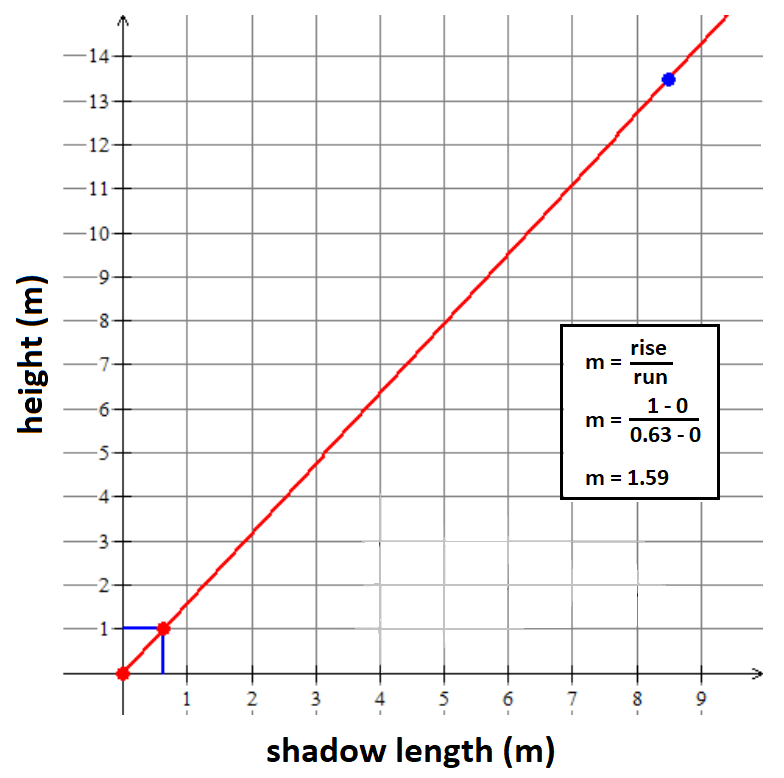
The equation that represents the relationship is y = 1.6x (we will round to 1 decimal place).
To determine the actual height of the flagpole, substitute x = 8.5 m into the equation and solve for y.
y = 1.6x
y = 1.6 (8.5)
y = 14 m
The height of the flagpole is 14 m.
Review
Given the two triangles, ΔABC and ΔDEF, which of the following statements is true?
a. AB corresponds to DF
b. AB corresponds to DE
c. AC corresponds to EF
d. BC corresponds to DE
b) AB corresponds to DE
Letters of the Greek alphabet (e.g.
Given the two triangles, ΔIJK and ΔXYZ, determine which of the following statements is true.
a. IJ corresponds to ZX and JK corresponds to XY
b. JK corresponds to XZ and YZ corresponds to IK
c. JK corresponds to XZ and IK corresponds to XY
d. JK corresponds to XY and IJ corresponds to XZ
b) JK corresponds to XZ and YZ corresponds to IK
Given the two triangles, ΔTUV and ΔABC, determine which of the following statements is true.
a. side TU is 21.6 cm
b. side TU is 5.1 cm
c. side TU is 7.5 cm
d. ΔTUV and ΔABC are not similar.
c) side TU is 7.5 cm. ΔTUV is a smaller triangle so the scale factor is between 0 and 1.
We can use the ordered pair (18.4, 10.8).
The scale factor or slope of the line is 0.59:
The equation of the line is y = 0.59x.
Substitute the value, x = 12.7
y = 0.59(12.7)
y = 7.5 cm
If ΔABC ~ ΔEFG, which of the following statements is true?
a. The scale factor to determine FG is 1.45
b. The length of side FG is 18.3 cm
c. The equation to determine side FG is y = 2.1x where x is side lengths of ΔABC and y is the side lengths of EFG
d. The length of side EF is 17.9 cm
c The equation to determine side FG is y = 2.1x; AC corresponds to EG.
m = 15.7/7.5
m = 2.1
So y = 21.x
 Triangle Information
Triangle Information
In Activity 4 you created a document, Working with Triangles, where you listed the different variations for using the trigonometric ratios and the Pythagorean Theorem for solving problems.
You have added information for each trigonometric ratio and the Pythagorean Theorem.
The Pythagorean Theorem was used in an example with an isosceles right triangle.
How can this be added to your listing of variations?
Finding the height of an object by measuring the length of its shadow was an example in Activity 4 and is an example in this activity also.
In Activity 4, the solution used a trigonometric ratio and in this activity the solution uses a proportion, ratio table or the equation of a line. Notice the difference in the information that is used in each case.
What value(s) must be included to use a trigonometric ratio that you do not see used in a similar triangle ratio?
Add a section to your chart that discusses the methods to solve for side lengths in similar triangles.
Similar triangles may or may not be right triangles. Include in your description:
- One pair of corresponding side lengths;
- One known side length in one triangle;
- When you can determine the length of the third side.
 Triangle Questions
Triangle Questions
Complete the questions in the document U2A8 Triangles.
CONSOLIDATION
You have been working with similar triangles. You have been introduced to some new notation.
- The use of Greek letters to say that two angles are equal
- The symbol, ~, which is used to say that two triangles are similar
You also revisited skills that you have learned in previous activities and used them to determine lengths of unknown sides in similar triangles. You worked with:
- A scale factor greater than 1
- A scale factor between 0 and 1
- Slope of a line
- Equation of a line that represents a proportional relation
- Pythagorean Theorem
 Journal Reflections
Journal Reflections
Open your document U2 Reflections.
Reflect on using linear equations, proportions and ratio tables to solve problems with similar triangles.
Which method do you prefer to use? Why? What do you need to learn to be more comfortable using the other methods?
Choose two sentence stems to lead your reflection today.